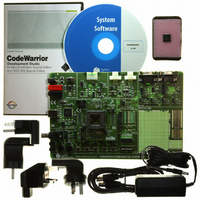EVB9S08DZ60 Freescale Semiconductor, EVB9S08DZ60 Datasheet - Page 325

EVB9S08DZ60
Manufacturer Part Number
EVB9S08DZ60
Description
BOARD EVAL FOR 9S08DZ60
Manufacturer
Freescale Semiconductor
Type
MCUr
Datasheets
1.DEMO9S08DZ60.pdf
(416 pages)
2.EVB9S08DZ60.pdf
(2 pages)
3.EVB9S08DZ60.pdf
(32 pages)
4.EVB9S08DZ60.pdf
(13 pages)
5.EVB9S08DZ60.pdf
(4 pages)
Specifications of EVB9S08DZ60
Contents
Module and Misc Hardware
Processor To Be Evaluated
S08D
Data Bus Width
8 bit
Interface Type
RS-232, USB
Silicon Manufacturer
Freescale
Core Architecture
HCS08
Core Sub-architecture
HCS08
Silicon Core Number
MC9S08
Silicon Family Name
S08D
Kit Contents
Board Cables CD Power Supply
Rohs Compliant
Yes
For Use With/related Products
MC9S08DZ60
Lead Free Status / RoHS Status
Lead free / RoHS Compliant
Available stocks
Company
Part Number
Manufacturer
Quantity
Price
Company:
Part Number:
EVB9S08DZ60
Manufacturer:
TI
Quantity:
101
- DEMO9S08DZ60 PDF datasheet
- EVB9S08DZ60 PDF datasheet #2
- EVB9S08DZ60 PDF datasheet #3
- EVB9S08DZ60 PDF datasheet #4
- EVB9S08DZ60 PDF datasheet #5
- Current page: 325 of 416
- Download datasheet (5Mb)
16.2.1.1
Control bits in the timer status and control register allow the user to select nothing (timer disable), the
bus-rate clock (the normal default source), a crystal-related clock, or an external clock as the clock which
drives the TPM prescaler and subsequently the 16-bit TPM counter. The external clock source is
synchronized in the TPM. The bus clock clocks the synchronizer; the frequency of the external source must
be no more than one-fourth the frequency of the bus-rate clock, to meet Nyquist criteria and allowing for
jitter.
The external clock signal shares the same pin as a channel I/O pin, so the channel pin will not be usable
for channel I/O function when selected as the external clock source. It is the user’s responsibility to avoid
such settings. If this pin is used as an external clock source (CLKSB:CLKSA = 1:1), the channel can still
be used in output compare mode as a software timer (ELSnB:ELSnA = 0:0).
16.2.1.2
Each TPM channel is associated with an I/O pin on the MCU. The function of this pin depends on the
channel configuration. The TPM pins share with general purpose I/O pins, where each pin has a port data
register bit, and a data direction control bit, and the port has optional passive pullups which may be enabled
whenever a port pin is acting as an input.
The TPM channel does not control the I/O pin when (ELSnB:ELSnA = 0:0) or when (CLKSB:CLKSA =
0:0) so it normally reverts to general purpose I/O control. When CPWMS = 1 (and ELSnB:ELSnA not =
0:0), all channels within the TPM are configured for center-aligned PWM and the TPMxCHn pins are all
controlled by the TPM system. When CPWMS=0, the MSnB:MSnA control bits determine whether the
channel is configured for input capture, output compare, or edge-aligned PWM.
When a channel is configured for input capture (CPWMS=0, MSnB:MSnA = 0:0 and ELSnB:ELSnA not
= 0:0), the TPMxCHn pin is forced to act as an edge-sensitive input to the TPM. ELSnB:ELSnA control
bits determine what polarity edge or edges will trigger input-capture events. A synchronizer based on the
bus clock is used to synchronize input edges to the bus clock. This implies the minimum pulse width—that
can be reliably detected—on an input capture pin is four bus clock periods (with ideal clock pulses as near
as two bus clocks can be detected). TPM uses this pin as an input capture input to override the port data
and data direction controls for the same pin.
When a channel is configured for output compare (CPWMS=0, MSnB:MSnA = 0:1 and ELSnB:ELSnA
not = 0:0), the associated data direction control is overridden, the TPMxCHn pin is considered an output
controlled by the TPM, and the ELSnB:ELSnA control bits determine how the pin is controlled. The
remaining three combinations of ELSnB:ELSnA determine whether the TPMxCHn pin is toggled, cleared,
or set each time the 16-bit channel value register matches the timer counter.
When the output compare toggle mode is initially selected, the previous value on the pin is driven out until
the next output compare event—then the pin is toggled.
Freescale Semiconductor
EXTCLK — External Clock Source
TPMxCHn — TPM Channel n I/O Pin(s)
MC9S08DZ60 Series Data Sheet, Rev. 4
Chapter 16 Timer/PWM Module (S08TPMV3)
325
Related parts for EVB9S08DZ60
Image
Part Number
Description
Manufacturer
Datasheet
Request
R
Part Number:
Description:
Manufacturer:
Freescale Semiconductor, Inc
Datasheet:
Part Number:
Description:
Manufacturer:
Freescale Semiconductor, Inc
Datasheet:
Part Number:
Description:
Manufacturer:
Freescale Semiconductor, Inc
Datasheet:
Part Number:
Description:
Manufacturer:
Freescale Semiconductor, Inc
Datasheet:
Part Number:
Description:
Manufacturer:
Freescale Semiconductor, Inc
Datasheet:
Part Number:
Description:
Manufacturer:
Freescale Semiconductor, Inc
Datasheet:
Part Number:
Description:
Manufacturer:
Freescale Semiconductor, Inc
Datasheet:
Part Number:
Description:
Manufacturer:
Freescale Semiconductor, Inc
Datasheet:
Part Number:
Description:
Manufacturer:
Freescale Semiconductor, Inc
Datasheet:
Part Number:
Description:
Manufacturer:
Freescale Semiconductor, Inc
Datasheet:
Part Number:
Description:
Manufacturer:
Freescale Semiconductor, Inc
Datasheet:
Part Number:
Description:
Manufacturer:
Freescale Semiconductor, Inc
Datasheet:
Part Number:
Description:
Manufacturer:
Freescale Semiconductor, Inc
Datasheet:
Part Number:
Description:
Manufacturer:
Freescale Semiconductor, Inc
Datasheet:
Part Number:
Description:
Manufacturer:
Freescale Semiconductor, Inc
Datasheet:











